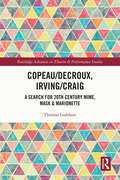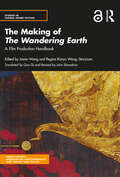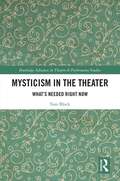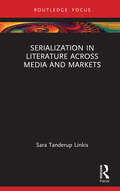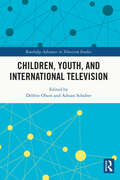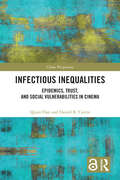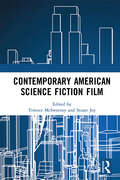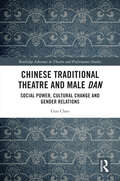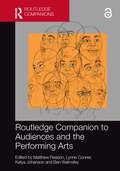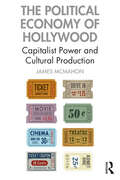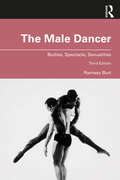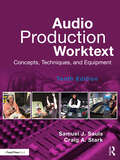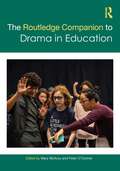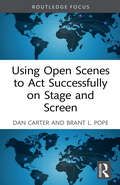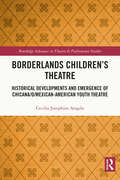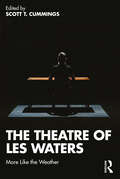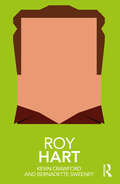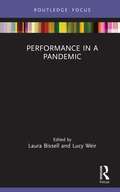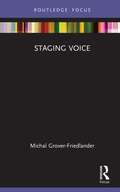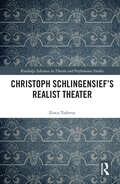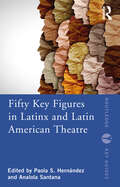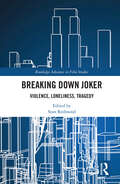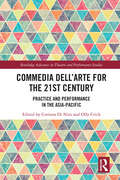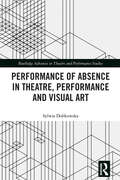- Table View
- List View
Copeau/Decroux, Irving/Craig: A Search for 20th Century Mime, Mask & Marionette (Routledge Advances in Theatre & Performance Studies)
by Thomas G LeabhartIn this series of essays, Thomas Leabhart presents a thorough overview and analysis of Etienne Decroux’s artistic genealogy. After four years’ apprenticeship with Decroux, Thomas Leabhart began to research and discover how forebears and contemporaries might have influenced Decroux’s project. Decades of digging revealed striking correspondences that often led to adjacent fields—art history, philosophy, and anthropology—forays wherein Leabhart’s appreciation of Decroux and his "kinsfolk," who themselves transgressed traditional frontiers, increased. The following essays, composed over a 30-year period, find a common source in a darkened Prague cinema where people gasped at a wooden doll’s sudden reversal of fortune. These essays: investigate the source of that astonishment; continue Leabhart's examination of Decroux’s "family tree"; consider how Copeau's and Decroux's keen observation of animal movement influenced their actor training; record the challenging and paradoxical improvisations chez Decroux; and recall Decroux’s debt to sculpture, poster art, sport and masks. These essays will be of great interest to students, scholars and practitioners in theatre and performance studies.
The Making of The Wandering Earth: A Film Production Handbook (Studies in Global Genre Fiction)
by Jiaren Wang and Regina Kanyu Wang, StorycomThis handbook takes us through the making of The Wandering Earth, one of the highest-grossing non-English films of all time. It is a rare, in-depth, behind-the-scenes study of the making of a masterpiece, taking the reader through the entire production process of a landmark Chinese science fiction film. The book brings to life how The Wandering Earth was created, from words to images, by a young and innovative professional team assembled by director Frant Gwo. It discusses specialized details of the filmmaking process and the collaborative work of the crew and the cast involved to present an intuitive feeling of the film’s production. A step-by-step guide on the making of a radical large-scale film, this handbook critically examines its various stages such as its development and production stages – the planning, preparing, recruiting, setting up departments and processes; writing the screenplay; creating a visual style and the production design; and the principal photography; its challenging post-production stages – the editing, visual effects production, color mixing; dubbing, sound editing; publicity, etc. Further, the chapters in volume also explore how Chinese science fiction films disrupt the Western narrative context and provide the larger discourse on Chinese science fiction. Richly illustrated with exclusive first-hand visuals from the making of the film, this handbook, part of the Studies in Global Genre Fiction series, will be an essential read for professionals, scholars, researchers, and students of film and media production, film studies, popular culture, cultural studies, Chinese studies, world literature, and science fiction. It will also be of interest to the general reader interested in filmmaking.
Mysticism in the Theater: What’s Needed Right Now (Routledge Advances in Theatre & Performance Studies)
by Tom BlockMysticism in the Theater introduces theater makers to the power and possibility of using historical mystical ideas to influence all aspects of a production. Historical mysticism represents ideas developed by recognized spiritual thinkers in all religions and time periods: individuals who stilled their ego, and perceived the unity of all, hidden within the apparent multiplicity of existence. This unique manner of spiritual inlay allows theatrical presentations to find the height of artistic expression: art at the intersection of our historical moment and the eternal. This study introduces theater makers to the history of mystical inspiration within performance work and develops strategies for inserting mystical ideas into their productions. The book ties this model into theatre’s history, as mystical ideas and quotes have been inserted into productions from Greek theatre through Shakespeare and into the present day. This book explores how teachings and ideas of specific historical mystical thinkers might influence all aspects of contemporary theatrical productions including writing, directing, acting, stagecraft/set design, lighting design, costume design, sound design, and choreography.
Serialization in Literature Across Media and Markets
by Sara Tanderup LinkisSerialization is an old narrative strategy and a form of publication that can be traced far back in literary history, yet serial narratives are as popular as ever. This book investigates a resurgence of serial narratives in contemporary literary culture. Analyzing series as diverse as Mark Z. Danielewski’s experimental book series The Familiar; audiobook series by the Swedish streaming service Storytel; children’s books by Lemony Snicket and Philip Pullman and their adaptations into screen; and serial writing and reading on the writing site Wattpad, the book traces how contemporary series at once are shaped by literary tradition and develop the format according to the logics of new media and digital technologies. The book sheds light on the interplay between the selected serials' narrative content and medial, social, and economic contexts, drawing on insights from literary studies, literary sociology, media studies, and cultural studies. Serialization in Literature Across Media and Markets thus contributes a unique and interdisciplinary perspective on a historical phenomenon that has proved ever more successful in contemporary media culture. It is a book for researchers and students of literature and media and for anyone who likes a good series and wants to understand why.
Children, Youth, and International Television (Routledge Advances in Television Studies)
by Debbie Olson Adrian SchoberThis volume explores how television has been a significant conduit for the public consumption of changing ideas about children, childhood, and national identity, via a critical examination of programs that prominently feature children and youth in international television. The chapters connect relevant cultural attitudes within their respective countries to an analysis of children and/or childhood in international children’s programming. The collection addresses how international children’s programming in global and local context informs changing ideas about children and childhood, including notions of individual and citizen identity formation. Offering new insights into childhood and television studies, this book will be of great interest to graduate students, scholars, and professionals in television studies, childhood studies, media studies, cultural studies, popular culture studies, and American studies.
Infectious Inequalities: Epidemics, Trust, and Social Vulnerabilities in Cinema
by Daniel R. Curtis Qijun HanThis book explores societal vulnerabilities highlighted within cinema and develops an interpretive framework for understanding the depiction of societal responses to epidemic disease outbreaks across cinematic history. Drawing on a large database of twentieth- and twenty-first-century films depicting epidemics, the study looks into issues including trust, distrust, and mistrust; different epidemic experiences down the lines of expertise, gender, and wealth; and the difficulties in visualizing the invisible pathogen on screen. The authors argue that epidemics have long been presented in cinema as forming a point of cohesion for the communities portrayed, as individuals and groups “from below” represented as characters in these films find solidarity in battling a common enemy of elite institutions and authority figures. Throughout the book, a central question is also posed: “cohesion for whom?”, which sheds light on the fortunes of those characters that are excluded from these expressions of collective solidarity. This book is a valuable reference for scholars and students of film studies and visual studies as well as academic and general readers interested in topics of films and history, and disease and society.
Contemporary American Science Fiction Film
by Terence McSweeneyContemporary American Science Fiction Film explores and interrogates a diverse variety of popular and culturally relevant American science fiction films made in the first two decades of the new millennium, offering a ground-breaking investigation of the impactful role of genre cinema in the modern era. Placing one of the most popular and culturally resonant American film genres broadly within its rich social, historical, industrial, and political context, the book interrogates some of the defining critical debates of the era via an in-depth analysis of a range of important films. An international team of authors draw on case studies from across the science fiction genre to examine what these films can tell us about the time period, how the films themselves connect to the social and political context, how the fears and anxieties they portray resonate beyond the screen, and how the genre responds to the shifting coordinates of the Hollywood film industry. Offering new insights and perspectives on the cinematic science fiction genre, this volume will appeal primarily to scholars and students of film, television, cultural and media studies, as well as anyone interested in science fiction and speculative film.
Chinese Traditional Theatre and Male Dan: Social Power, Cultural Change and Gender Relations (Routledge Advances in Theatre & Performance Studies)
by Guo ChaoThis book examines male dan, a male actor who performs female roles in Chinese theatre. Through the rise, fall and tenuous survival of male dan in Chinese history, Guo Chao reflects the transformations in the social zeitgeist in China, especially the politics of gender and sexuality. The breadth of this study reflects a diversified set of sources, ranging from classical to contemporary texts (texts of jingju plays, memoirs, collections of notation books) and other commentaries and critical evaluations of dan actors (in both English and Chinese languages), to video and audio materials, films, and personal interviews. This book will be of great interest to students and scholars of East Asian/Chinese studies across the fields of theatre, history, culture, and literature.
Routledge Companion to Audiences and the Performing Arts (Audience Research)
by Matthew ReasonThe Routledge Companion to Audiences and the Performing Arts represents a truly multi-dimensional exploration of the inter-relationships between audiences and performance. This study considers audiences contextually and historically, through both qualitative and quantitative empirical research, and places them within appropriate philosophical and socio-cultural discourses. Ultimately, the collection marks the point where audiences have become central and essential not just to the act of performance itself but also to theatre, dance, opera, music and performance studies as academic disciplines. This Companion will be of great interest to academics, researchers and postgraduates, as well as to theatre, dance, opera and music practitioners and performing arts organisations and stakeholders involved in educational activities.
The Political Economy of Hollywood: Capitalist Power and Cultural Production
by James McMahonIn Hollywood, the goals of art and business are entangled. Directors, writers, actors, and idealistic producers aspire to make the best films possible. These aspirations often interact with the dominant firms that control Hollywood film distribution. This control of distribution is crucial as it enables the firms and other large businesses involved, such as banks that offer financing, to effectively stand between film production and the market. This book analyses the power structure of the Hollywood film business and its general modes of behaviour. More specifically, the work analyses how the largest Hollywood firms attempt to control social creativity such that they can mitigate the financial risks inherent in the art of filmmaking. Controlling the ways people make or watch films, the book argues, is a key element of Hollywood’s capitalist power. Capitalist power—the ability to control, modify, and, sometimes, limit social creation through the rights of ownership—is the foundation of capital accumulation. For the Hollywood film business, capitalist power is about the ability of business concerns to set the terms that will shape the future of cinema. For the major film distributors of Hollywood, these terms include the types of films that will be distributed, the number of films that will be distributed, and the cinematic alternatives that will be made available to the individual moviegoer. Combining theoretical analysis with detailed empirical research on the financial performance of the major Hollywood film companies, the book details how Hollywood’s capitalist goals have clashed with the aesthetic potentials of cinema and ultimately stymied creativity in the pursuit of limiting risk. This sharp critique of the Hollywood machine provides vital reading for students and scholars of political economy, political theory, film studies, and cinema.
The Male Dancer: Bodies, Spectacle, Sexualities
by Ramsay BurtThis revised third edition of The Male Dancer updates and enlarges a seminal book that has established itself as the definitive study of the performance of masculinities in twentieth century modernist and contemporary choreography. In this authoritative and lively study, Ramsay Burt presents close readings of dance works from key moments of social and political change in the norms around gender and sexuality. The book’s argument that prejudices against male dancers are rooted in our ideas about the male body and behaviour has been extended to take into account recent interdisciplinary discussions about whiteness, intersectionality, disability studies, and female masculinities. As well as analysing works by canonical figures like Nijinsky, Graham, Cunningham, and Bausch, it also examines the work of lesser-known figures like Michio Ito and Eleo Pomare, as well as choreographers who have recently emerged internationally like Germaine Acogny and Trajal Harrell. The Male Dancer has proven to be essential reading for anyone interested in dance and the cultural representation of gender. By reflecting on the latest studies in theory, performance, and practice, Burt has thoroughly updated this important book to include dance works from the last ten years and has renewed its timeliness for the 2020s.
Audio Production Worktext: Concepts, Techniques, and Equipment
by Samuel J. Sauls Craig A. StarkNow in its tenth edition, the Audio Production Worktext offers a comprehensive introduction to audio production in radio, television, and film. This hands-on, student-friendly text demonstrates how to navigate modern radio production studios and utilize the latest equipment and software. Key chapters address production planning, the use of microphones, audio consoles, and sound production for the visual media. The reader is shown the reality of audio production both within the studio and on location. New to this edition is material covering podcasting, including online storage and distribution. The new edition also includes an updated glossary and appendix on analog and original digital applications, as well as self-study questions and projects that students can use to further enhance their learning. The accompanying instructor website has been refreshed and includes an instructor’s manual and PowerPoint images. This book remains an essential text for audio and media production students seeking a thorough introduction to the field.
The Routledge Companion to Drama in Education
by Mary McAvoyThe Routledge Companion to Drama in Education is a comprehensive reference guide to this unique performance discipline, focusing on its process-oriented theatrical techniques, engagement of a broad spectrum of learners, its historical roots as a field of inquiry and its transdisciplinary pedagogical practices. The book approaches drama in education (DE) from a wide range of perspectives, from leading scholars to teaching artists and school educators who specialise in DE teaching. It presents the central disciplinary conversations around key issues, including best practice in DE, aesthetics and artistry in teaching, the histories of DE, ideologies in drama and education, and concerns around access, inclusivity and justice. Including reflections, lesson plans, programme designs, case studies and provocations from scholars, educators and community arts workers, this is the most robust and comprehensive resource for those interested in DE’s past, present and future.
Using Open Scenes to Act Successfully on Stage and Screen
by Dan Carter Brant L. PopeUsing Open Scenes as a "way in" to scripted material, this book establishes a foundational actor training methodology that can be applied to the performance of film or television acting, commercials, and theatrical realism. Unlike other methodologies, this unique approach is devoid of casting considerations or imposed identity, providing actors opportunities that do not rely on nor are restricted by age, gender, race, ethnicity, regional accent, body type, identity, or other defining or delimiting aspects that come into play during the casting process. This allows the actor to focus on personal authenticity as they develop their skills. This book will appeal to undergraduate students, acting teachers, and the contemporary actor seeking a career in film, television, or other electronic media. Visit the companion website www.usingopenscenestoactsuccessful.godaddysites.com for additional Open Scenes and more.
Borderlands Children’s Theatre: Historical Developments and Emergence of Chicana/o/Mexican-American Youth Theatre (Routledge Advances in Theatre & Performance Studies)
by Cecilia Josephine AragónThis book chronicles the child performer as part of the Chicana/o/Mexican-American theatre experience. Borderlands Children’s Theatre explores the phenomenon of the Chicana/o/Mexican-American child performer at the center of Chicana/o and Latina/o theatre culture. Drawing from historical and contemporary theatrical traditions to finally the emergence of Latina/o Youth Theatre and Latina/o Theatre for Young Audiences, it raises crucial questions about the role of the child in these performative contexts and about how childhood and adolescence was experienced and understood. Analyzing contemporary plays for Chicana/o/Mexican-American child performer, it introduces theorizations of "performing mestizaje" and "border crossing" borderlands performance, gender, and ethnic identity and investigates theatre as a site in which children and youth have the opportunity to articulate their emerging selfhoods. This book adds to the national and international dialogue in theatre and gives voice to Chicana/o/Mexican-American children and youth and will be of great interest to students and scholars of Theatre studies and Latina/o studies.
The Theatre of Les Waters: More Like the Weather
by Scott T. CummingsThe Theatre of Les Waters: More Like the Weather combines original writings from Les Waters with short essays by a wide range of his collaborators, creating a personal and multi-faceted portrait of an influential director, revered mentor, and inspirational theatre artist. The book begins with a critical introduction of Waters’s work, followed by essays written by a wide range of Waters's collaborators over the past four decades. These essays are framed by shorter pieces of writing by Waters himself: reflections, inspirations, observations, and personal anecdotes. At the heart of this book lies the notion that the director’s central position in theatrical production is defined by collaboration and that a study of directing should take into account how a director works with playwrights, designers, actors, stage managers, and dramaturgs to turn artistic vision into concrete reality on stage. An insightful resource for early career or student directors in theatre programs, The Theatre of Les Waters sheds light on the art of theatre directing by exploring the work of a major theatre artist whose accomplished career sits at the heart of American theatre in the 21st century. Drawing on aspects of memoir, case study, interview, miscellany, biography, and criticism, this is also an enlightening read for anyone with an interest in how theatre artists bring their creative vision to life.
The Art of Knife Fighting for Stage and Screen: An Actor’s and Director’s Guide to Staged Violence
by Erick Vaughn WolfeThe Art of Knife Fighting for Stage and Screen: An Actor’s and Director’s Guide to Staged Violence provides detailed information for the safe use of knives and daggers in a theatrical setting and an in-depth understanding of safe theatrical weapons. The book starts with an extensive safety review, then moves on to the basic techniques of dagger fighting, starting with grip and body postures. Readers will then learn about the basic actions of cuts, parries, blocks, and disarms. During this process, they will explore the connection between body and weapon and start learning the elements of storytelling through choreography. Special attention is given to suicides, threats, and murder and how directors, choreographers, performers, teachers, and students can approach these techniques in a way that is physically and mentally safe. The book also covers the use of throwing knives, knife flips, and other tricks to help add a little flair to your fight. The Art of Knife Fighting for Stage and Screen teaches the safe theatrical use of the knife for directors, performers, educators, and students of stage combat.
Roy Hart (Routledge Performance Practitioners)
by Bernadette Sweeney Kevin CrawfordRoy Hart’s revolutionary work on the human voice through extended vocal technique and the Wolfsohn-Hart tradition has influenced several generations of practitioners. Hart’s outstanding contribution to vocal research, practice and performance stretched over 20 years until his untimely death in 1975, and his vocal training produced performers with extraordinary and highly expressive vocal ranges. He founded a theatre company, Roy Hart Theatre, that brought his ideas to realisation in ground-breaking works. His influence, through his own use of the voice for theatre and music and its embodiment in his company, was widespread, attracting the interest of directors such as Peter Brook, Jerzy Grotowski and Jean-Louis Barrault. This book combines: a detailed biography giving the social and artistic context of Hart’s work and that of the early Roy Hart Theatre an exploration of Hart’s own writings on his work, combined with a review of articles by his wife Dorothy Hart and in-depth interviews a stylistic analysis of his key works, including The Bacchae, and, L'Economiste and Biodrame, and their critical reception pathways into some of the practical exercises devised by close collaborators of Roy Hart and practitioners of the Roy Hart Theatre Tradition. As a first step towards critical understanding, and as an initial exploration before going on to further, primary research, Routledge Performance Practitioners offer unbeatable value for today’s student.
Performance in a Pandemic
by Laura BissellThis edited collection gathers UK and international artists, academics, practitioners, and researchers in the fields of contemporary performance, dance, and live art to offer creative-critical responses to the impact of the COVID-19 pandemic on their work. Themes addressed in these case studies include the ways in which liveness functions across digital platforms, the new demands on audiences and performance-makers, and the impact on international festivals as the digital removes geographical and locational restrictions. Brought together, these examples capture the creative activity and output that this unexpected cultural moment has provoked. Creative-critical responses interrogate what the global pandemic has taught us about what it is to make live work during lockdown and explore what the future of performance-making in a post-COVID world might look like. For all scholars and performance-makers whose work brings them into the sphere of contemporary art and culture, this is an essential and stimulating account of practice at the beginning of the 2020s.
Staging Voice (Routledge Voice Studies)
by Michal Grover-FriedlanderStaging Voice is a unique approach to the aesthetics of voice and its staging in performance. This study reflects on what it would mean to take opera’s decisive attribute—voice—as the foundation of its staged performance. The book thinks of staging through the medium of voice. It is a nuances exploration, which brings together scholarly and directorial interpretations, and engages in detail with less frequently performed works of major and influential 20th-century artists—Erik Satie, Bertolt Brecht and Kurt Weill—as well as exposes readers to an innovative experimental work of Evelyn Ficarra and Valerie Whittington. The study is intertwined throughout with the author’s staging of the works accessible online. This book will be of great interest to students and scholars in voice studies, opera, music theatre, musicology, directing, performance studies, practice-based research, theatre, visual art, stage design, and cultural studies.
Christoph Schlingensief's Realist Theater (Routledge Advances in Theatre & Performance Studies)
by Ilinca TodorutThis book is the first study of the prolific German filmmaker, performance artist, and TV host Christoph Schlingensief (1960–2010) that identifies him as a practitioner of realism in the theater and lays out how theatrical realism can offer an aesthetic frame sturdy enough to hold together his experiments across media and genres. This volume traces Schlingensief’s developing realism through his theater work in conventional theater venues, in less conventional venues, his opera work focusing on the production of Wagner’s Parsifal at Bayreuth, and his art installations on revolving platforms called Animatographs. This book will be of great interest to scholars of theater, film, and performance art and practitioners.
Fifty Key Figures in LatinX and Latin American Theatre (Routledge Key Guides)
by Paola S HernándezFifty Key Figures in Latinx and Latin American Theatre is a critical introduction to the most influential and innovative theatre practitioners in the Americas, all of whom have been pioneers in changing the field. The chosen artists work through political, racial, gender, class, and geographical divides to expand our understanding of Latin American and Latinx theatre while at the same time offering a space to discuss contested nationalities and histories. Each entry considers the artist’s or collective’s body of work in its historical, cultural, and political context and provides a brief biography and suggestions for further reading. The volume covers artists from the present day to the 1960s—the emergence of a modern theatre that was concerned with Latinx and Latin American themes distancing themselves from an European approach. A deep and enriching resource for the classroom and individual study, this is the first book that any student of Latinx and Latin American theatre should read.
Breaking Down Joker: Violence, Loneliness, Tragedy (Routledge Advances in Film Studies)
by Sean RedmondBreaking Down Joker offers a compelling, multi-disciplinary examination of a landmark film and media event that was simultaneously both celebrated and derided, and which arrived at a time of unprecedented social malaise. The collection breaks down Joker to explore its aesthetic and ideological representations within the social and cultural context in which it was released. An international team of authors explore Joker’s sightlines and subtexts, the affective relationships, corrosive ideologies and damning if ambivalent messages of this film. The chapters address such themes as white masculinity, identity and perversion, social class and mobility, urban loneliness, movement and music, and questions of reception and activism. With contributions from scholars from screen studies, theatre and performance studies, psychology and psychoanalysis, geography, cultural studies and sociology, this fully interdisciplinary collection offers a uniquely multiple operational cross-examination of this pivotal film text, and will be of great importance to scholars, students and researchers in these areas.
Commedia dell’Arte for the 21st Century: Practice and Performance in the Asia-Pacific (Routledge Advances in Theatre & Performance Studies)
by Olly Crick Corinna Di NiroThis book discusses the evolution of Commedia dell’Arte in the Asia-Pacific where through the process of reinvention and recreation it has emerged as a variety of hybrids and praxes, all in some ways faithful to the recreated European genre. The contributors in this collection chart their own training in the field and document their strategies for engaging with this form of theatre. In doing so, this book examines the current thoughts, ideas, and perceptions of Commedia – a long-standing theatre genre, originating in a European-based collision between neo-classical drama and oral tradition. The contributing artists, directors, teachers, scholars and theatre-makers give insight into working styles, performance ideas, craft techniques and ways to engage an audience for whom Commedia is not part of their day-to-day culture. The volume presents case studies by current practitioners, some who have trained under known Commedia ‘masters’ (e.g. Lecoq, Boso, Mazzone-Clementi and Fava) and have returned to their country of origin where they have developed their performance and teaching praxis, and others (e.g. travelling from Europe to Japan, Thailand, Singapore and China) who have discovered access points to share or teach Commedia in places where it was previously not known. This book will be of great interest to students and scholars in Performing arts, Italian studies, and History as well as practitioners in Commedia dell’Arte.
Performance of Absence in Theatre, Performance and Visual Art (Routledge Advances in Theatre & Performance Studies)
by Sylwia DobkowskaThis research project investigates the concepts of absence across the disciplines of visual art, theatre, and performance. Absence in the centre of an ideology frees the reader from the dominant meaning. The book encourages active engagement with theatre theory and performances. Reconsideration of theories and experiences changes the way we engage with performances, as well as social relations and traditions outside of theatre. Sylwia Dobkowska examines and theorises absence and presence through theatre, performance, and visual arts practices. This book will be of great interest to students and scholars of theatre, visual art and philosophy.
